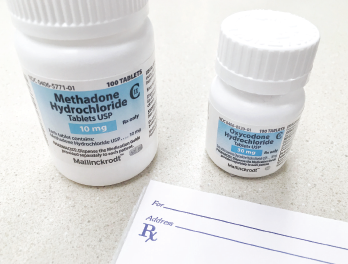
PureRadiancePhoto / shutterstock.com
The prevalence of chronic opioid use among patients with rheumatoid arthritis (RA) doubled between 2002 and 2015, especially among patients with severe pain or on antidepressants, according to a new study.1
The study adds to prior data reporting trends in chronic opioid use in RA patients.2,3 Severe pain was the strongest predictor for use of chronic opioids, with hazard ratio of 2.53 (95% confidence interval [CI], 2.19–2.92).
“It was interesting that this relationship was independent of RA disease activity. In other words, the association between pain and chronic opioid use wasn’t solely because they had uncontrolled inflammation from the RA; they may have had pain due to other causes as well,” says the study’s lead author, Yvonne C. Lee, MD, MMSc, an associate professor in the Division of Rheumatology at Northwestern Medicine, Chicago.
This observation points to the need for clinicians to accurately identify the cause of patients’ pain and treatment with disease-modifying anti-rheumatic drugs, she says.
The Study
In the study, Dr. Lee and colleagues used data from 33,739 RA patients identified through the Corrona registry from 2002–15. Since 2002, the Corrona registry has enrolled >42,000 persons with RA through both academic and community rheumatologists.
To calculate the annual prevalence of chronic opioid use in this cohort, the investigators defined chronic opioid use as any opioid use reported by patients during two or more consecutive study visits.

Dr. Lee
The study found chronic opioid use more than doubled from 2002–15 among these patients, from 7.4% in 2002 to 16.9% in 2015. An even greater increase was found among RA patients who contributed two or more data points in a given year, with a prevalence of 14.1% in 2002 rising to 31.3% in 2015.
Dr. Lee and colleagues also looked at potential predictors of chronic opioid use in 26,288 patients who were not taking opioids at baseline. They looked at both patient characteristics (e.g., age, ethnicity, sex) and RA disease characteristics (e.g., seropositivity, disease duration, disease activity), along with medication use.
The Clinical Disease Activity Index score was used to measure disease activity, disability was assessed using the Health Assessment Questionnaire, and pain intensity was assessed using a scale of 0–100 based on the question, “How much pain have you had because of your arthritis in the past week?”1
Following severe pain, the second strongest predictor was antidepressant use, with a hazard ratio of 1.79 (95% CI, 1.64-1.92). Less strong, but still predictive of chronic opioid use, was high disease activity, with a hazard ratio of 1.55 (95% CI, 1.30–1.84), and high level of disability, with a hazard ratio of 1.45 (95% CI, 1.27–1.65).
Variability in Prescribing Habits

Dr. Solomon
“[Although] almost all patients with RA have some degree of chronic pain, the vast majority do not require chronic opioids,” says the study’s senior author, Daniel H. Solomon, MD, MPH, a professor of medicine in the Division of Rheumatology and Immunology at Harvard Medical School, Boston. He added that he and colleagues, in a study yet to be published, found “some rheumatologists are more likely to give chronic opioids than other rheumatologists, even after controlling for patient factors.”
This observation supports data previously published by Curtis et al. that found “tremendous variability” in how U.S. rheumatologists prescribe opioids.2
“[Although] overall, about 40% of older RA patients used opioids, in some rheumatology practices it was more than 80% and in other practices it was less than 10%,” says Jeffrey R. Curtis, MD, MPH, the Marguerite Jones Harbert–Gene V. Ball Endowed Professor of Medicine in the Division of Clinical Immunology & Rheumatology at the University of Alabama, Birmingham.
Clinical Takeaways

Dr. Curtis
Given a lack of data on long-term benefit of opioids, Dr. Curtis says, “I [think] that as a bridge to therapy, opioids may be okay in the short term, but it would be highly desirable to get people off them if possible.
“Similar to glucocorticoid management, clinicians may forget they should try to taper opioids as patients’ disease activity improves with effective RA therapy,” he says.
Dr. Curtis also emphasizes the predictive association between antidepressant use and chronic opioid use found in the study by Lee et al. “I think rheumatologists may not be as sensitized to thinking about the need to screen for depression in these patients, but this work underscores the importance of doing so.”
Dr. Solomon says the key to helping RA patients is to treat the RA early and completely as guidelines recommend. Although he thinks patients with chronic pain not controlled by other means are candidates for opioids, he stresses the substantial risk of chronic opioid use.
Mary Beth Nierengarten is a freelance medical journalist based in Minneapolis.
References
- Lee YC, Kremer J, Guan H, et al. Chronic opioid use in rheumatoid arthritis: Prevalence and predictors. Arthritis Rheumatol. 2019 May;71(5):670–677.
- Curtis JR, Xie F, Smith C, et al. Changing trends in opioid use among patients with rheumatoid arthritis in the United States. Arthritis Rheumatol. 2017 Sep;69(9):1733–1740.
- Zamora-Legoff JA, Achenbach SJ, Crowson CS, et al. Opioid use in patients with rheumatoid arthritis 2005–2014: A population-based comparative study. Clin Rheumatol. 2016 May;35(5):1137–1144.


